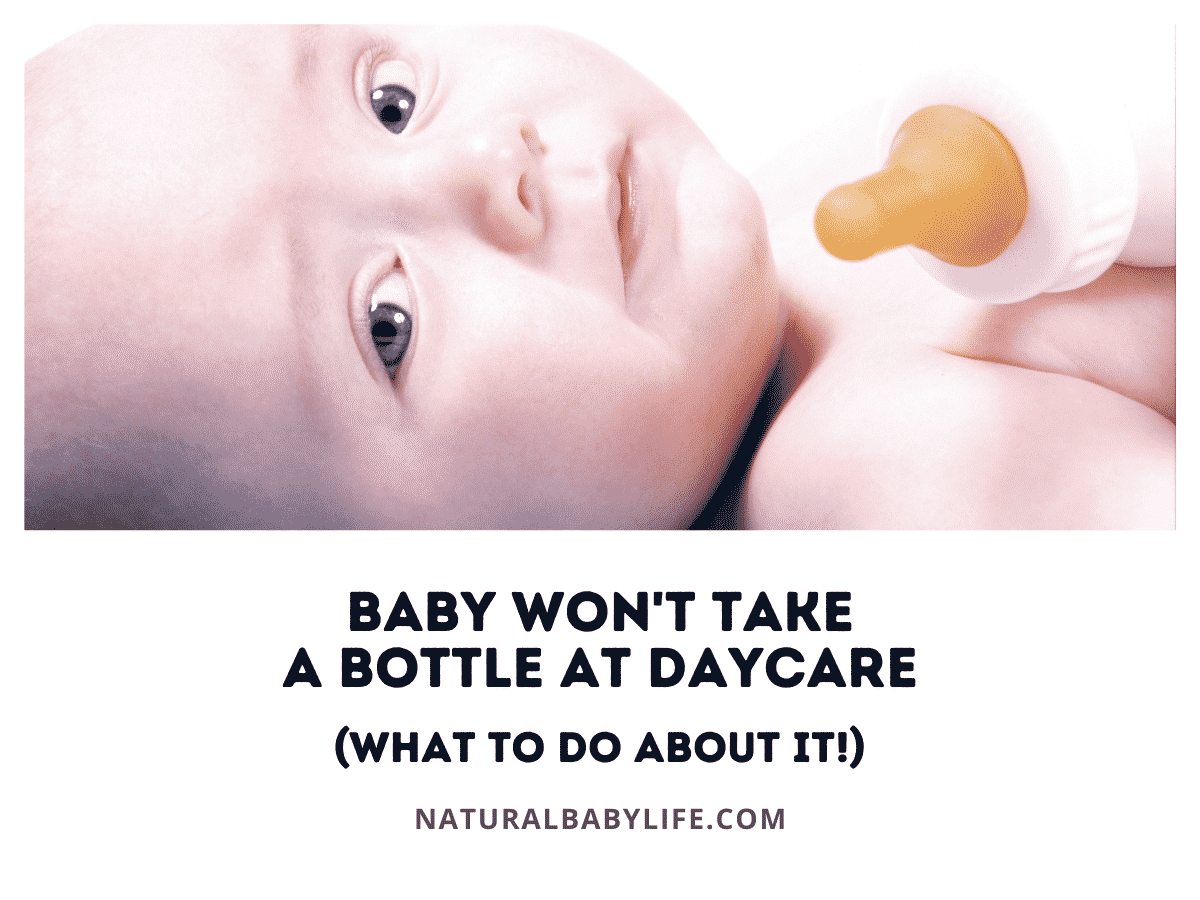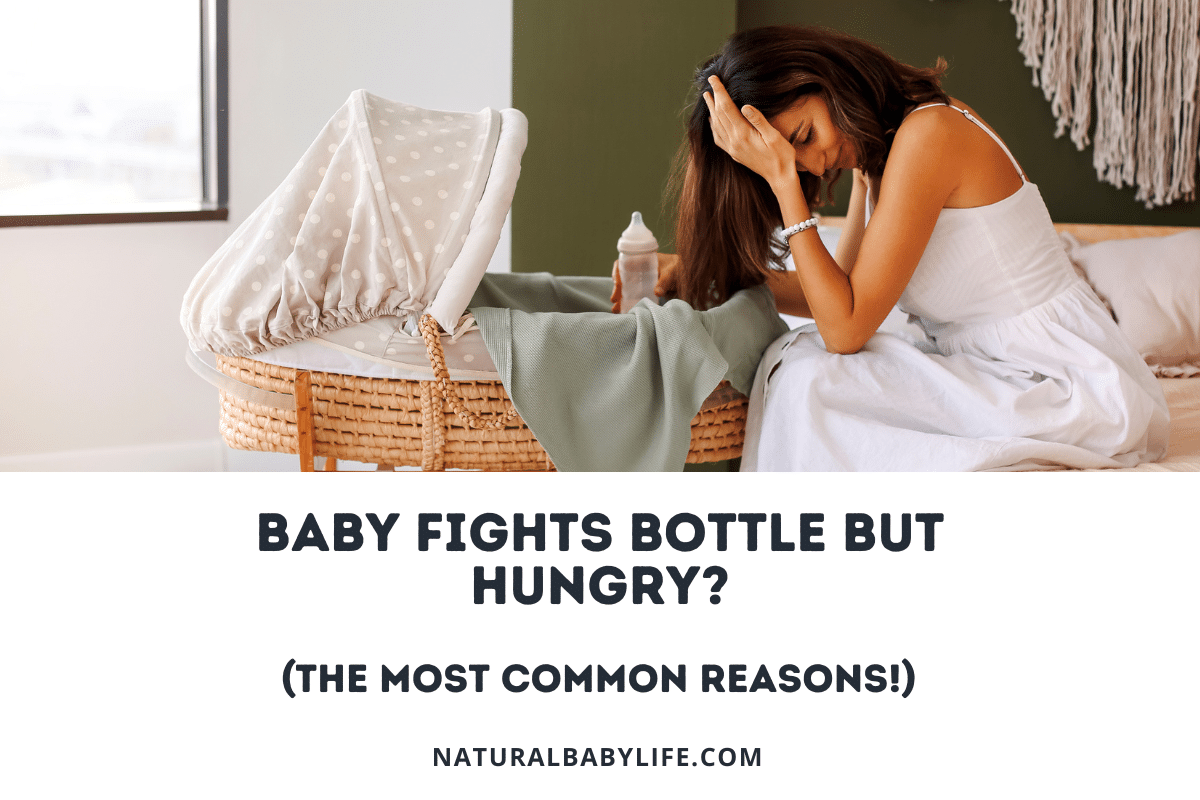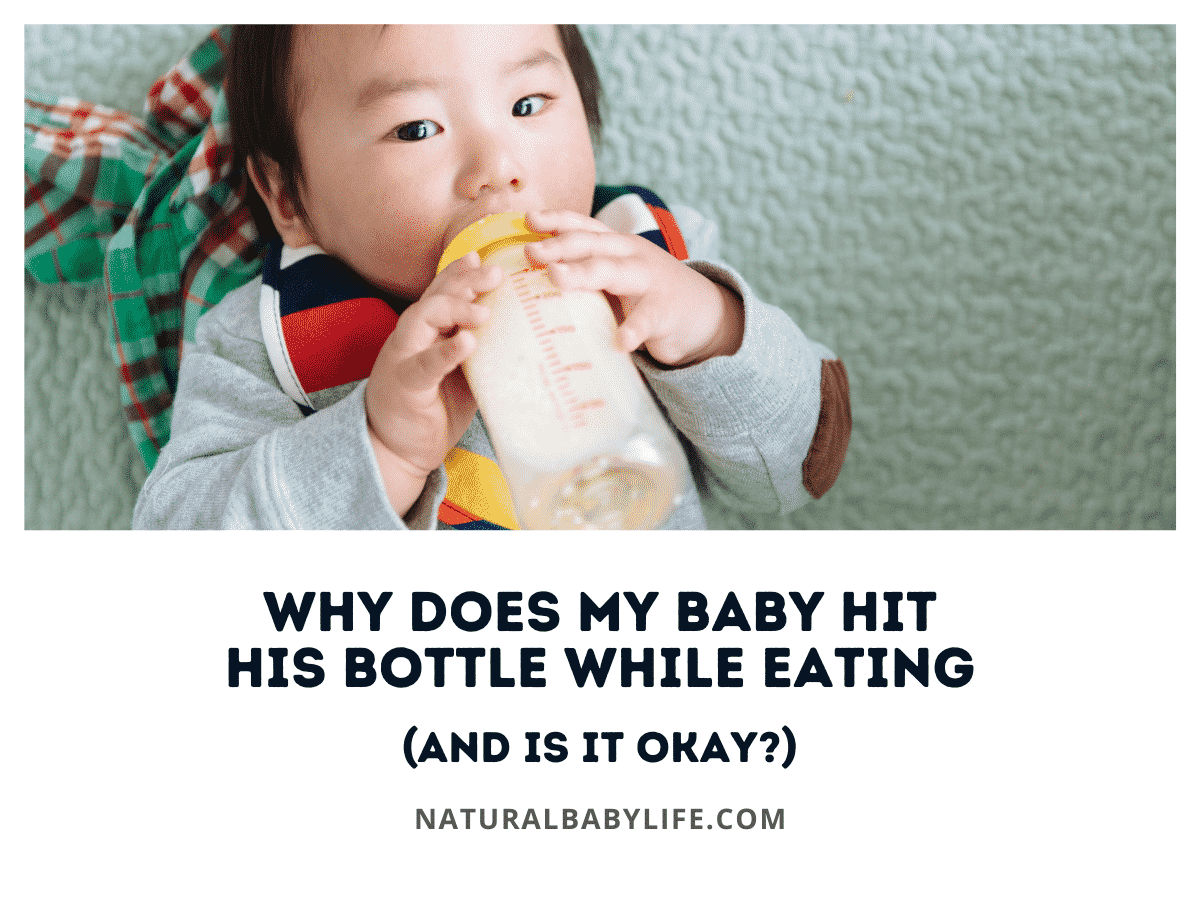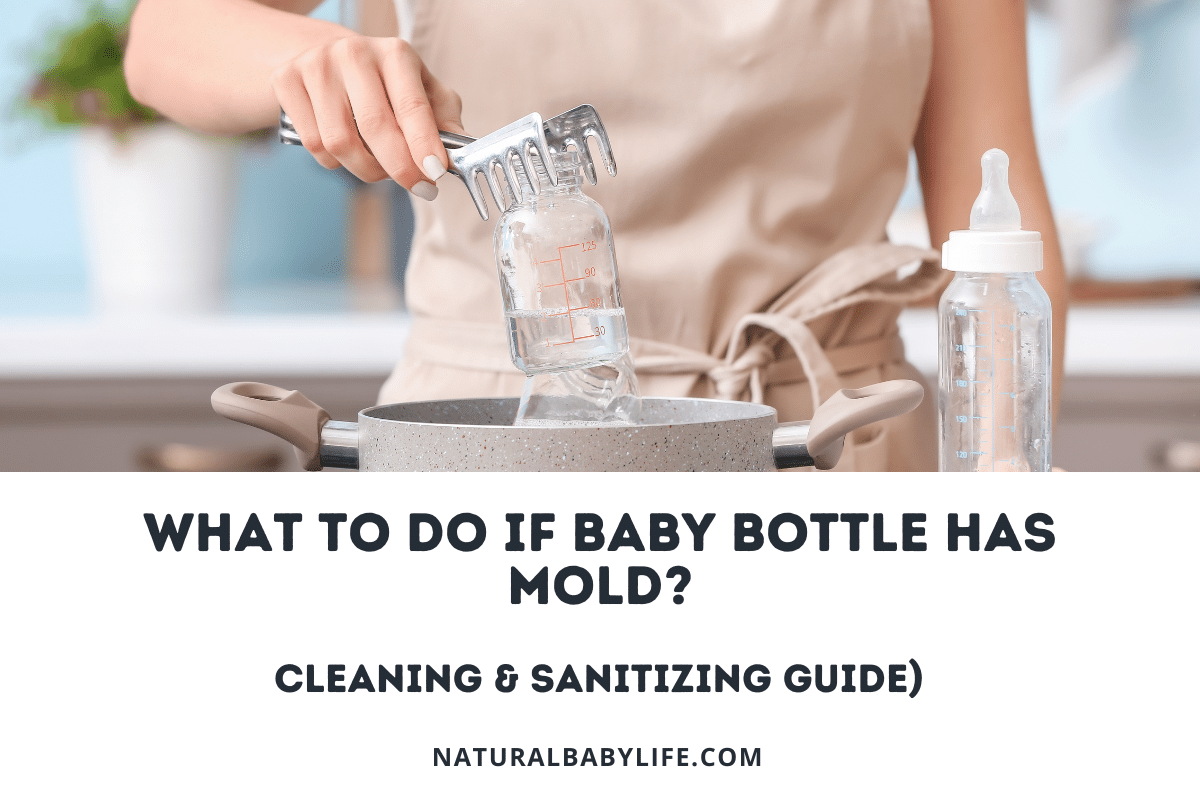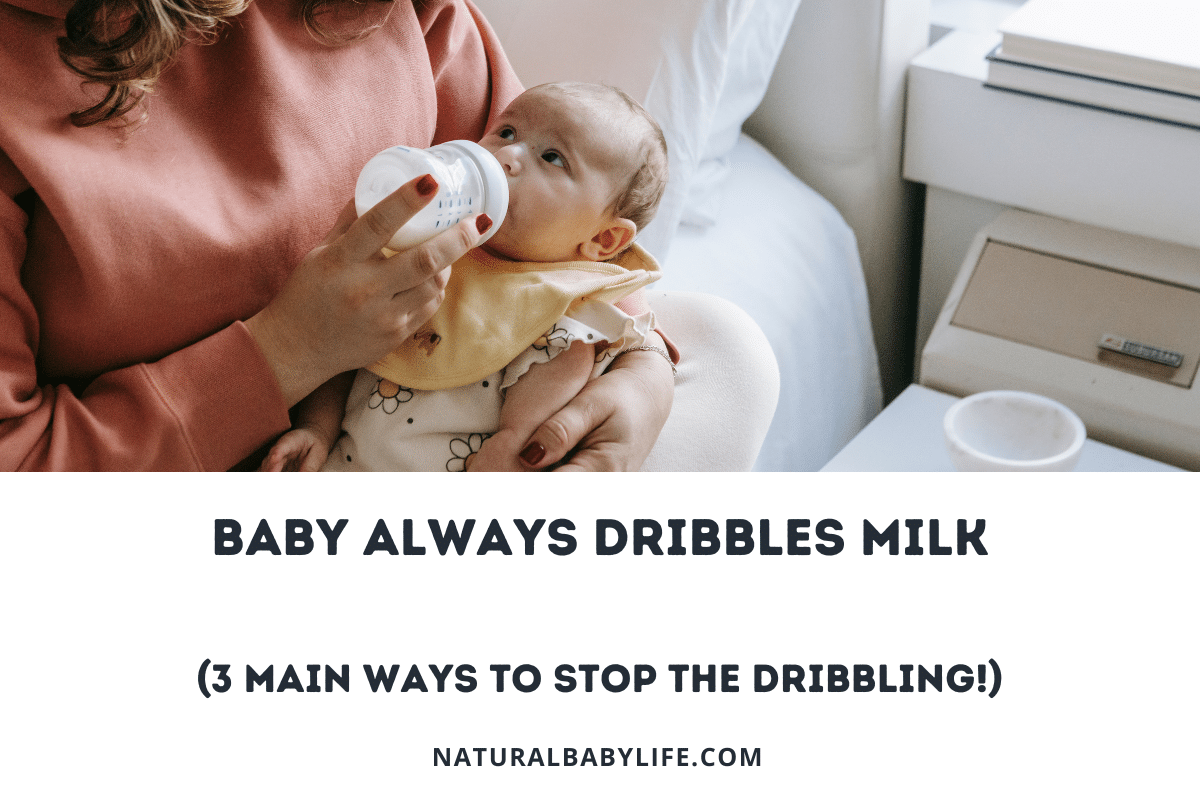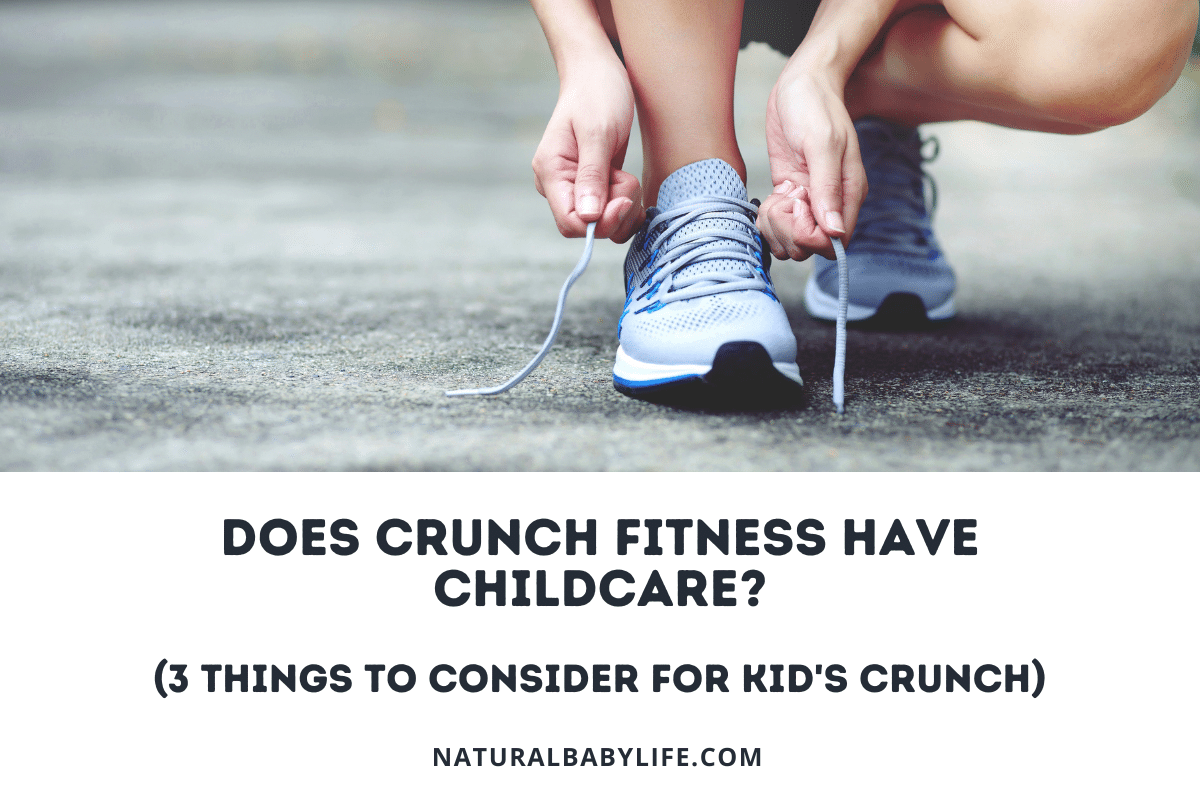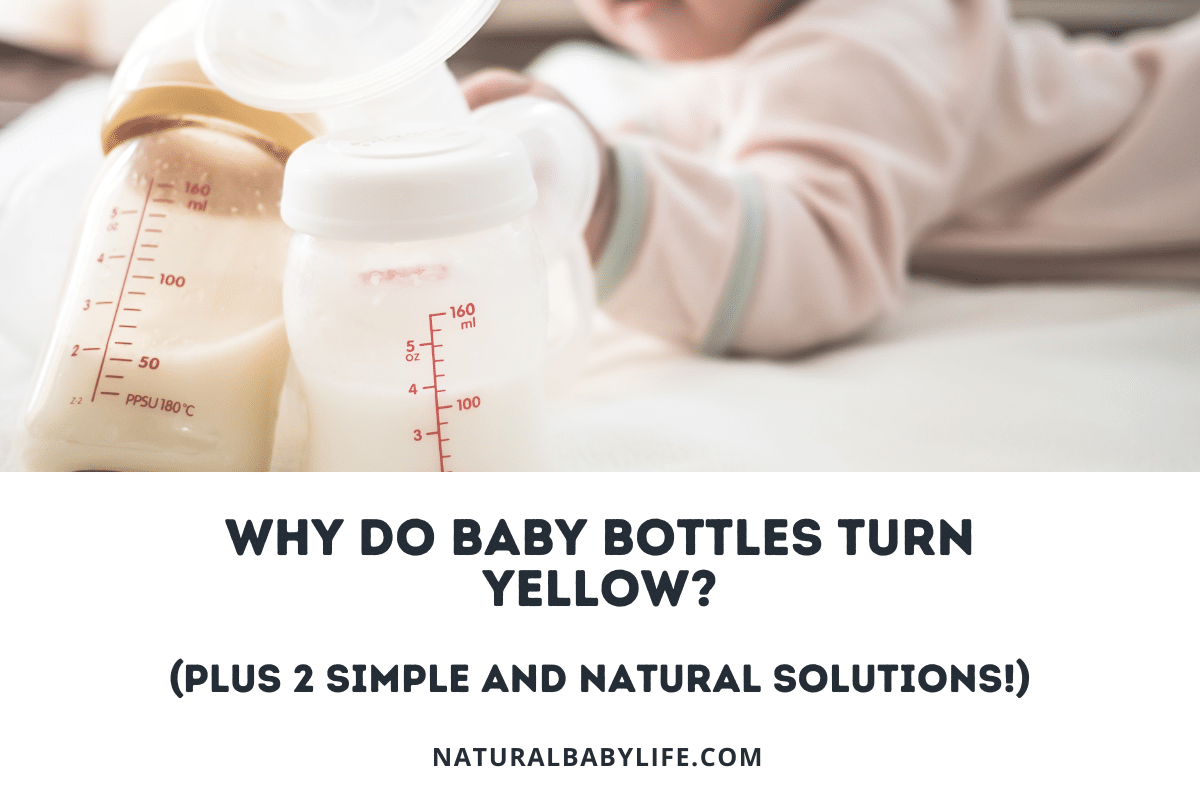If your baby won’t take a bottle at daycare, don’t worry – it’s pretty normal and happens to almost every baby at some point. Figuring out why the baby won’t take a bottle is the first step, and it can be for a variety of reasons. It can be alarming if your baby stops taking a bottle at daycare, but caregivers should be willing and able to work with you to find a solution.
It is especially common for breastfed babies to be resistant to the bottle at daycare because they prefer the breast. Other reasons may include bottle malfunctions, teething, positioning, or even milk temperature or quality.
Don’t freak out if your baby stops eating at daycare. It may take at least two weeks before they settle into a routine, but it will happen. Keep reading to find out more about getting your baby used to feeding at daycare and some tips on how to ease the transition.
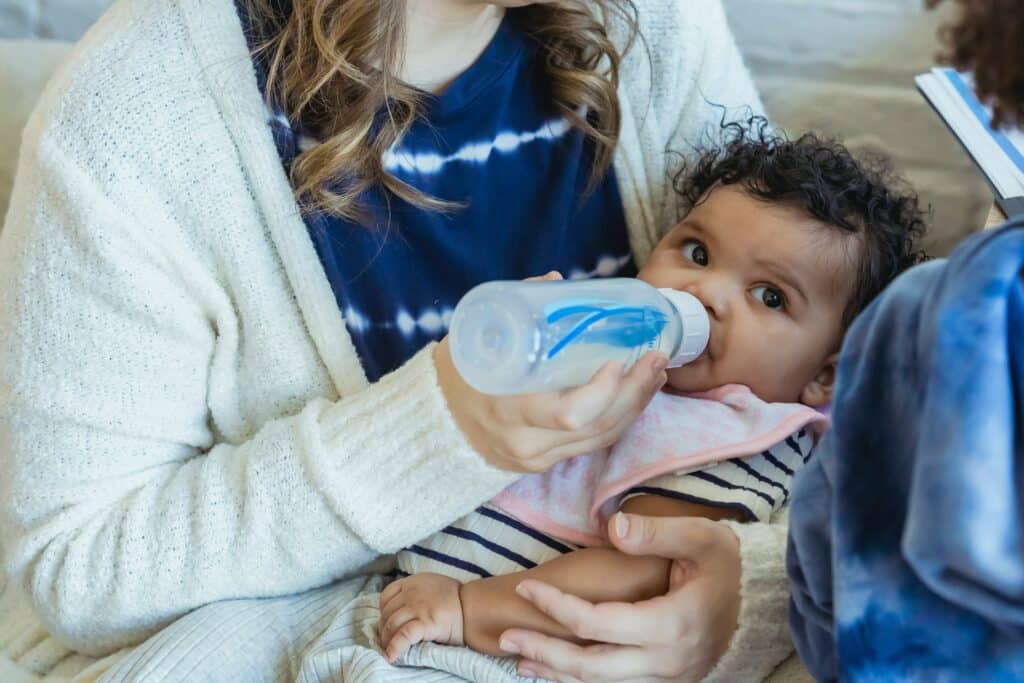
Table of Contents
What to do if your baby won’t take a bottle at daycare
When your baby transitions to daycare, it will no doubt rock their world and can sometimes lead to behavioral issues. Just think about a brand new environment – new people, new smells and sounds, lots of distractions, and no mom or dad! Even something as simple as having a new person holding them can stress your little one out.
Though there isn’t a lot of research, most studies focus on breastfeeding moms who report that the transition to a bottle at daycare can cause distress. Anecdotal evidence from baby blogs indicates that many formula-fed babies have the same issue. Most moms report that their baby initially refused a bottle at daycare – both breastfed and formula-fed – for the first two weeks.
If you find yourself in the position where your baby won’t take a bottle at daycare, here are some tips that can help ease the transition:
- Feeding plan – Create a detailed outline of your feeding routine and preferences.
- Feeding routine – Use the same process for feeding at daycare as you do at home.
- Communicate with the caregiver – Talk to your caregiver about your concerns and ensure that they use your feeding plan.
In many cases, your baby just needs a couple of weeks to transition. After they’ve gotten used to their new routine, they’ll begin taking milk or formula for the bottle with ease.
What is a feeding plan?
A feeding plan details your feeding routine and preferences and helps keep you and the daycare providers on the same page about what works best for your baby. There is no limit to what your feeding plan can include, so be specific to what your baby prefers or just describe step-by-step what you do at home.
Your feeding plan is a way to indicate everything from your baby’s preferred position to their preferred milk temperature. If you prefer feeding on demand, be sure to describe your baby’s feeding cues.
As of 2016, 41 states required feeding plans due to issues with overweight babies. Here is an example of a feeding plan template from the University of North Carolina.
What is a feeding routine?
You already know your baby thrives on routine, but you may not think about how important is it to establish elements of a feeding routine that can transfer from home to daycare.
A feeding routine means using the same series of steps each time your baby eats. Babies constantly experience new things in their world, so creating a feeding routine will help your baby feel comfortable enough to eat in their new daycare environment.
Start your baby in the same position at home – and make sure it’s in your feeding plan. If the position preference changes, be sure to notify your daycare provider.
It can also help to create an environment similar to home by appealing to all of your baby’s senses. Bring something that smells like mom or dad such as a blanket to cuddle with during feeding for comfort. Even something like a sound machine played at feeding time or a certain calming song or book can help you establish a routine.
When should I talk to my baby’s caregiver?
If you have any concerns about your baby taking a bottle or your baby is already refusing a bottle, it’s important to stay in communication with your baby’s caregiver. This communication is essential for a positive experience. There are very clear state standards set for feeding in care facilities, so first be sure you are aware of those regulations.
Most regulations address feeding on demand, holding babies while being fed, and emphasizing knowing hunger cues. In addition, most have strict rules regarding carrying, propping, and sleeping with bottles.
While regulations are a positive step, we have no way of knowing if they are being followed. Make yourself familiar with your state’s regulations and the specific policies at your baby’s daycare provider.
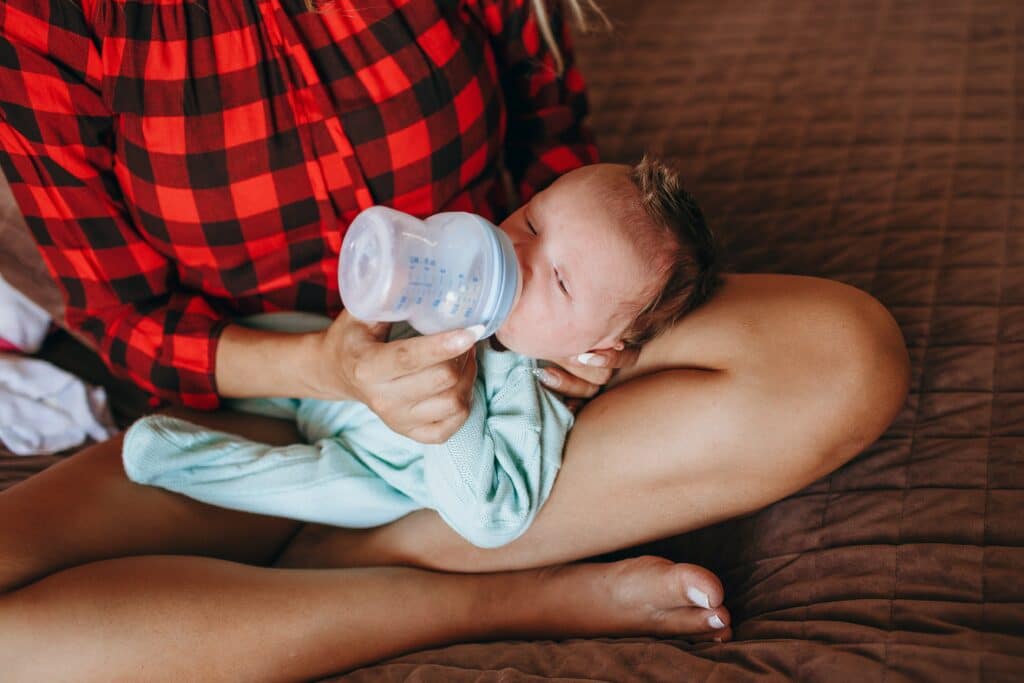
Why do babies refuse bottles?
If you’re past the two-week window and your baby still refuses a bottle, there might be a larger issue at work than just the transition to a new routine.
Babies may refuse to eat at daycare for a variety of reasons. There may be changes that are still keeping your little one from establishing a routine, they may be hitting a developmental milestone that makes them fussy and more difficult to feed overall, or it may be an issue with the bottle, nipple, or milk.
It can also be difficult to get to the root of the problem because there may be more than one reason your child is rejecting the bottle, including:
- Pumped breastmilk preparation – If your baby is used to nursing, they may not be excited about being given stored breastmilk. It’s difficult for babies to transition from being comforted at mom’s breast to drinking breastmilk from a bottle.
- Bottle or nipple issues – Your baby’s bottle (or the nipple) may need to be replaced or cleaned, or it’s possible that your baby is rejecting the bottle simply because the detergent is different from the one you use at home. If you are bottle-feeding for the first time, you may be finding out that not all babies like all types of bottles or nipples and sometimes you need to experiment to find the right fit.
- Ready for a sippy cup – At around 5-6 months, your baby may start to prefer a sippy cup over a bottle. At this point, you should try to synchronize the transition and introduce your baby to the sippy cup at home as well as at daycare.
- Formula preparation – Your baby may reject their bottle if the formula tastes different than what they get at home. Brand, temperature, water type, and preparation variances can change the flavor in ways that your baby may not enjoy.
- Teething – Babies may reject the bottle when they start teething. Check for swollen gums and excessive drool to see if teething is causing their discomfort.
- Disruption to the daycare schedule – If your baby used to eat at daycare but has stopped suddenly, you may want to ask what has changed there. Even though your little one’s schedule may look the same to you – same drop-off time, same pick-up time, even the same room – there may be differences during the day that are making it difficult for them to adjust.
If all else fails, talk to your baby’s pediatrician. If you’re a breastfeeding mother, a lactation consultant may also be able to offer guidance.
Is the bottle or nipple the problem?
A bottle malfunction or issue could be the problem. Although it’s easy to fix, it’s hard to diagnose if you aren’t there.
Check for proper nipple flow and that the bottle is assembled correctly and has no cracks. Be sure that you are using the same bottle at home and at daycare. Also, check cleaning practices – something as simple as a scented dish soap at daycare could create distress for your baby.
If possible, it may be easier to switch out a previously loved bottle with a new one of the same style.
Should I try a new bottle or nipple?
Some babies are very particular about their bottles and nipples, especially if you are breastfeeding at home. It can be an uphill climb until you find the right bottle, but trying to figure this out before daycare is a great idea. If you can’t find the right bottle in advance, you can always send several options to daycare.
If you’re breastfeeding, try bottles that most closely resemble the mother’s nipple. Practice at home by having your partner or another close person feed the baby with mama out of the room. Your baby may be ready to upgrade to a high-flow nipple if they are older, and breastfed babies may get particularly fussy if the flow isn’t comparable to mom’s nipple.
Using the pinky trick also helps with nipple confusion; you let the baby suck on your pinky first and then slowly substitute the nipple.
Is my baby ready for a sippy cup?
If your baby is 5-6 months old, it might be time for a sippy cup!
A sippy cup increases the flow and requires a different kind of sucking technique. It also gives your baby autonomy, which older infants love. If you think your baby may be ready for this transition, practice at home with some water until they get used to the new technique.
Is there a problem with the milk?
Your baby may be rejecting their bottle because the milk or formula has gone bad or simply doesn’t taste as good as they expect.
If you’re breastfeeding, be sure that the daycare providers know how to thaw the milk to your baby’s preferred temperature. Demonstrate this for them if need be, as it is easy to overheat or underheat breastmilk, especially when they don’t know to stir it and check it before offering it to your baby. Also, it’s important to ensure it hasn’t soured.
Another option may be to offer formula instead of breastmilk when at daycare. Be sure your formula hasn’t expired and that they aren’t using leftover formula from previous days.
Should I premix the bottles at home?
Getting the right ratio is key to a happy baby who gains weight over time.
Even the water that you use may alter the flavor, so either mix your formula at home or provide pre-measured portions of water and formula for your daycare provider.
Also check to be sure that they are giving your baby the formula you provided.
Could teething keep my baby from eating?
As surprising as it may be, your little one may be sprouting their first tooth! According to the Children’s Hospital of Los Angeles, teething usually begins around four months and can last until eight months for front teeth alone! Overall, however, the entire process lasts for 30-36 months, and that’s a long time to deal with swollen gums.
The sucking technique required to drink from a bottle can be painful when gums are inflamed and sensitive, so be ready to adapt when the telltale drool begins to hang from your baby’s mouth. Some parents swear by milk pops, which involve freezing breastmilk or formula on a pacifier.
You can also supplement by using a syringe and slowly feeding the baby bit by bit to avoid painful sucking.
When should I talk to my pediatrician?
If you’ve tried the above tips but your baby is still refusing a bottle at daycare, it might be time to have a conversation with your pediatrician about other issues that may be causing it. This is especially necessary if your baby starts to refuse the bottle at home. It can also give you peace of mind to call and check, so trust your gut!

How can I help my breastfed baby take a bottle?
Babies who are exclusively breastfed may not want to take a bottle at daycare. Since formula-fed babies are already taking a bottle at home, most babies who have issues with taking a bottle at daycare are babies who are used to nursing. If your breastfed baby refuses a bottle, your best bet may be to start using a bottle at home as well, at least until they get used to it.
If your breastfed baby won’t take a bottle, consider these tips:
- Always start when your little one is happy. Don’t wait until they’re tired, cranky, and hungry to try and give them a bottle.
- Let your baby explore the bottle first without trying to get them to drink from it. If they’re old enough, this might look like letting them hold it to get a feel for the bottle.
- Some parents swear by the pinky trick when transitioning to a bottle: let the baby suck on your pinky first and then slowly replace it with the bottle nipple.
- Try the syringe method. Allow the baby to suck on your pinky while slowly dispensing milk through a syringe. Then gradually replace the pinky with a bottle’s nipple.
- Have someone other than mom give the bottle. For many breastfed babies, they are more likely to take a bottle from dad or someone else they trust, since they’ll want to nurse when mom’s around.
- Stay positive while trying to give your baby a bottle. If they start to get frustrated or upset, stop and try again later to avoid any negative associations.
- Experiment with different types of bottles or nipple sizes. Start with just one or two different types of bottles, since purchasing a bunch of different bottles can be expensive and often, counterproductive.
It can be frustrating when your baby won’t take a bottle at daycare, but keep practicing and be as patient as you can be. Unless there’s an underlying issue, most babies will get used to the bottle over time.
Frequently Asked Questions (FAQs)
What do I do when baby won’t take bottle from anyone but mom?
Mom is usually the main source of comfort for a baby, so it’s not surprising when they prefer mom over everyone else. It may more difficult to get baby to take a bottle from someone else while mom is around, so try having someone give baby a bottle after mom has left the room. If they still won’t take a bottle, keep practicing and try some different feeding positions and bottle types to find one your baby is comfortable with.
Why isn’t my baby eating at daycare?
There are numerous reasons why a baby may refuse a bottle at daycare. It’s often because they’re in a new environment with new people, which can be a difficult transition for them. Establishing a consistent feeding plan and routine is one of the best ways to encourage your baby to eat at daycare the way they do at home.
Why won’t my 3-month-old eat at daycare?
At 3 months old, babies are starting to learn a little bit more about the world around them. If your baby won’t eat at daycare, it may be because they’re getting used to the transition of being at daycare instead of home with their parents. Try a different type of bottle or a different feeding position and let them get used to the bottle before encouraging them to drink from it.
Conclusion
It can be worrisome for many parents when their baby refuses a bottle at daycare. Although there are some cases where there’s an underlying issue, most of the time, babies just need time to adjust. There are many ways to help your baby become more comfortable with the bottle and they’ll start to drink from the bottle when they’re ready.

